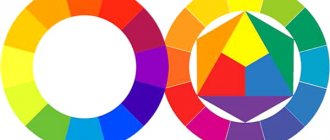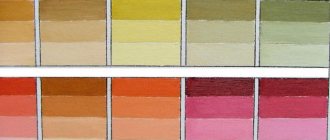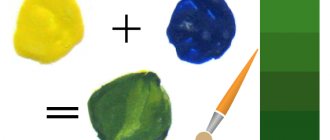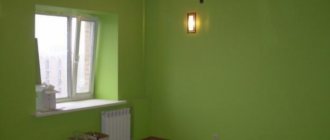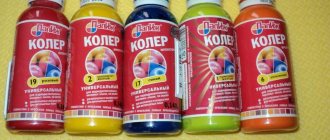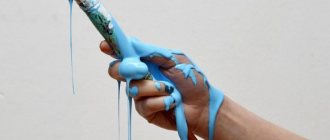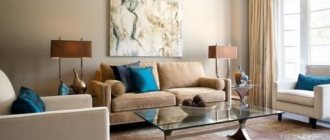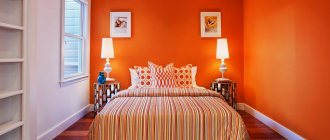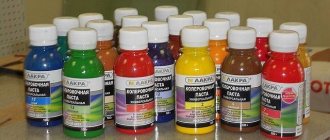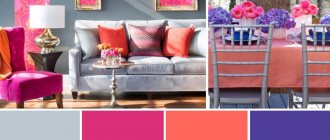What colors need to be mixed to get a cream color?
Preparation and main process
- Mix yellow, red, brown and dilute with white. ...
- Mix yellow, pink, white. ...
- Combine white paint and golden ocher (approximately 60 and 40% respectively). ...
- Combine scarlet, blue, yellow colors, dilute the mixture well with white.
Interesting materials:
How to get from Pulkovo to Moscow station? How to get from Russia to Iceland? How to get there from Sabiha Gokcen? How to get from Ataturk Airport to Taksim? How to get from Sheremetyevo Airport to Kazansky Station? How to get from Ataturk to the center of Istanbul? How to get from Planernaya metro station to Sheremetyevo? How to get from the rest station to Zhukovsky airport? How to get from the train station to Zhulyany airport? How to get from Domodedovo to Kursk station?
Features of olive color and its shades
In contrast to the bright shades of green, which symbolize playful youth, the color of the olive is considered a reflection of mature wisdom. It is associated with loyalty and mutual understanding. When surrounded by this tone, people gain confidence and a sense of calm, which is why it is widely used by artists and designers.
olive color in the interior
olive color in clothes
oil painting
Olive shades
Olive is a complex shade of green obtained by combining different colors and combinations.
If we give it an accurate description, we can say that it is a dark yellowish-green color.
An example of a classic tone is the color of canned olives. Its shades have a wide range of colors from dark pistachio to brown-green.
- Golden-olive - a shade of green with a predominance of yellow;
- Classic olive - a successful combination of red, blue and yellow without any admixture of gray or black;
- Olive khaki - differs from the classics with a slightly larger amount of blue pigment and a small amount of gray
- Light Olive , or Drab , is a muted color that has a white tone to it. It is present in the coloring of protective suits of the ground forces of some countries.
- Dark olive is a complex color based on a mixture of green and brown colors.
- Gray-olive - an ashy shade of olive with the addition of gray color. Similar to Khaki color.
Olive shades
What's the main point?
The key stage in creating a marine composition using the Resin Art technique is the implementation of waves and sea foam, which, of course, can be painted with the same acrylic paints. The idea is great, but, you see, scientific and technological progress is moving forward, improving and making our lives easier here and there, so why not take advantage of its “gifts”? Thus, thanks to the efforts of Italian technologists, the unique powder additive Wave Pro was born, which makes the waves more openwork, more like real ones!
Wave Powder
Materials
The materials we will need are:
- High density epoxy resin "Art Pro Black":
- -15%
Super-thick epoxy painting resin “Art-Pro Black” 3.4 kg
4735 rub. 4030 rub. Add to cart
- Super-thick epoxy resin for painting “Art-Pro Black” 1.7 kg
2400 rub. Add to cart
- Not available
Super-thick epoxy resin for painting “Art-Pro Black” 850 g1290 rub. More details
- Super-thick epoxy resin for painting “Art-Pro Black” 510 g
910 rub. Add to cart
- Super-thick epoxy resin for painting “Art-Pro Black” 8.5 kg
9950 rub. Add to cart
- -15%
- Set of dyes in a marine palette* or Wave Pro pigment additive (not needed if you bought a set of dyes, the additive is included in the set):
- “Wave-Pro” for creating the effect of real waves
From 145 rub. Choose …
- Set of dyes in a marine palette
835 rub. Add to cart
- “Wave-Pro” for creating the effect of real waves
- Marine decor:
- Stabilized moss 20 g 4 colors
165 rub. Choose …
- Not available
Sea pebbles 100/300 grFrom 150 rub. More details
- Miniature shells 3 types
From 180 rub. Choose …
- Not available
Quartz sand 100/300 grFrom 55 rub. More details
- Sea shell “Ocean Treasure” (5-8 pcs)
160 rub. Add to cart
- Stabilized moss 20 g 4 colors
- Base for filling (Art board, cutting board, countertop, etc.):
- “Simple” boards
From 125 rub. Choose …
- “Inside” boards
From 495 rub. Choose …
- Clock boards
From 900 rub. Choose …
- “Simple” boards
- Hair dryer or technical hair dryer
- Manual gas burner, set of accessories And electronic scales:
- Manual gas burner
395 rub. Add to cart
- Grade 5.00 out of 5
Pocket electronic scales up to 500 g
From 610 rub. Choose …
- Set of accessories for working with resin
185 rub. Add to cart
- Grade 4.50 out of 5
Electronic scales up to 7 kg
640 rub. Add to cart
- Manual gas burner
* – dyes for epoxy resin may not be needed if you first paint a marine background with acrylic paints on a blank for pouring. However, be sure that the paints are completely dry before working with resin.
We also have a ready-made kit that already includes all the necessary materials, including step-by-step instructions for creating a sea:
Necessary materials for creating a painting in a marine style
What does the serpentine sea fish moray eel look like?
All representatives of this species are large in size. The body length of the moray eel ranges from 60 to 370 centimeters. And one individual weighs from 8 to 40 kilograms! These are the underwater giants!
The body shape of these fish is slightly flattened: the front part of the body is thicker than the back. The pectoral fins familiar to us, characteristic of most representatives of the fish class, are completely absent in moray eels. The snake-like fish has an elongated muzzle, and its eyes have a very evil expression!
Mediterranean moray eels (Muraena helena) resemble giant leeches.
The color of animals is usually motley. Very often there is a pattern of small specks on the body; sometimes moray eels have a striped pattern on the body. These snake-like fish have no scales.
Kinds
The genus includes 10 species of moray eels:
- appendiculata - found off the Chilean coast;
- argus - distributed off the coast of Peru, Galapagos Islands, Mexico;
- augusti - Atlantic near North Africa and southern Europe;
- clepsydra - Costa Rica, Colombia, Panama, Mexico;
- Muraena helena, or European, has been studied better than others by ichthyologists and is often encountered by divers. The main range is in the Mediterranean Sea, but can also be found in the eastern Atlantic;
- lentiginosa - eastern Pacific waters;
- melanotis - east and west Atlantic;
- pavonina, or spotted one, also lives in warm Atlantic waters;
- retifera - reticulated, when studying this particular species, a second jaw was discovered in the pharynx;
- robusta - eastern equatorial Atlantic.
These creatures are extremely diverse. The color, mainly camouflage, matches the color of the bottom, and can be marbled, spotted, striped, greenish-brown, light brown, yellowish, almost white. They also differ in size - large, medium, small.
The closest relatives from the same family are Gymnothoraxes. Also vary from small to hefty. The range of the black-spotted gymnatorax is Indo-Pacific; it feeds on small fish and crustaceans. The black dot does not grow longer than 80 cm. But its neighbor in its range, the Javan, reaches three meters in length and is capable of devouring a reef or tiger shark, and it is better for divers not to get in its way.
Freshwater
Freshwater moray, or Gymnothorax tile, is only called that - in fact it is a marine inhabitant. Small - about 60 cm. Biological characteristics and high adaptability allow it to live in fresh water bodies for a long time. The reservoir can be fresh up to 5 ppm. Feels great in salt water. Suitable habitats include both river estuaries (estuaries with expansion towards the sea) and coastal waters of Indonesia, the Philippines, and India.
Gold (yellow)
The golden one has other names: golden-tailed, yellow canary and even bastard eel. According to eyewitnesses, it looks like a floating banana, and the photos confirm this. Often the banana’s skin is also decorated with dark spots, and its mouth is white, which further enhances the resemblance. This is a small moray eel - size from 5 to 40 cm, in some cases it grows only up to 70. It lives throughout the western Atlantic - from Florida and Bermuda to southeastern Brazil. It is also found on the Cape Verde Islands, off the coast of Africa.
Black
British naturalist Mark Catesby, author of The Natural History of California, Florida and the Bahamas, described a certain species of moray eel - maculata nigra. He himself sketched and etched images of animals and plants on boards. There is a drawing and engraving from its original (dating back to 1750) - a black fish lies on the bottom, resting under the canopy of skinny coral and wrapping its tail around it.
Mediterranean
The Mediterranean moray (helena) is the most studied. The maximum body length is 1.5 m. It is not subject to mass fishing, but is sometimes caught individually - as a sport or for meat, on a hook or using traps.
Electric
And this creature is mythical. The myth arose due to its resemblance to an eel. Electric eels do exist - scientists recently analyzed data on them and identified three different species (previously it was thought there was one, Electrophorus electricus).
Green
Green Gymnothorax is a large, longest specimen measuring 2.5 m in length and weighing 29 kg. Found in the western Atlantic and northern Gulf of Mexico to Brazil. Occasionally settles near ports.
Photo gallery
The choice of interiors in olive color is explained by the relevance of natural motifs and colors. In the photo you can see how relaxed and calm this design looks and how it has a beneficial effect on the nervous system. If you want to bring comfort and relaxation to your home, then this option is perfect.
Color theory Your color type on the sofa and sofa cushions and sofas can be a greenish sofa curtains for a sofa and sofas fundamental sofas from Straight sofas Corner sofas Modular sofas in gray white or white beige
bedsliving roomverysinglearmrestsmodernpinkupholsteryquantityinexpensivemodeltotalnamesmallloftblockshelvessoprojectchairssourcearmchairs
Where is it used?
Okay, we know that clay can color something, so what? Beets are also colored, but we don’t discuss them. In fact, ocher is a very cheap natural pigment; you literally take clay, dry it in industrial ovens and sell it in bags.
And its reserves are restored by nature itself. Need I say that it is used in a lot of places in our everyday life? But let's be more specific.
Makeup
A very stable and safe pigment, it does not cause skin irritation (if there is no allergy), and gives a natural, soft color. It is often used in natural cosmetics, but rarely as a primary pigment.
Many people buy ocher pigment not for decorative cosmetics, but for care products. In many practices it is considered beneficial for the skin and overall health. In decorative cosmetics it is most often used in shadows, giving the same palette of colors as everywhere else.
Cloth
It is very stable and will not be damaged by washing or exposure to the sun. Plus, she is cheap, so entry into the fashion world is always open to her. Yellow ocher is often used in clothing, ranging in color from sand to mustard. But there are other options.
This color is suitable for ladies with dark hair, the colors should contrast. In terms of the combination within the image, everything is complicated. The very rich palette of ocher colors causes inconvenience. Some combinations will be good with a sand coat and completely different ones with a red-brown coat.
The most neutral combinations are with white, gray and black. And then it’s a matter of taste and wardrobe capabilities. Lilac, brick, and emerald look great with light shades. With dark ones - purple, coral, pink. In a light look, an ocher accent, such as a bag or scarf, will look especially good.
Interior
Being a very stable pigment, ocher is added to almost all types of paints. So you can paint any part of the interior with this color. By the way, in Greenland it is customary to paint the exterior walls of houses with ocher.
In the interior, ocher is also ambiguous, but due to associations. If there is a lot of it, then ocher is associated with autumn shades and foliage. And if it’s not enough, then with sunshine, warmth and hope. You can use such an interior in any room, just remember that the shades of this group whet the appetite.
It is recommended to combine it with white, black and natural forest colors: different shades of green, brown, red. For completeness, you can add a blue “sky”. Since ocher can be combined with any natural shades, there are practically no restrictions on colors in the interior: cold, warm, tones and halftones.
There are two options for incorporating it into the interior. If the room is already made in some natural shade, for example, blue, then an ocher accent will make it more expressive. This could be chairs, sofa cushions or part of the furniture.
If you plan to wallpaper in this shade, then you can add one or more interior details to them, but not many. For example, a bedspread or pillows, a lamp or a figurine. The main thing is not to overdo it, otherwise “sunny” turns into “depressive”.
Pigment
It is resistant to painting any surfaces (within reasonable limits, I doubt that it will withstand the space shuttle) and is safe for humans. But our world is not ideal and the right paint may not be in the right shade.
Fortunately, ocher is sold as a pigment. Anyone can buy it to create their own shadows, their own unique shade for a painting, or innovative paint for the space shuttle.
Porcelain
An interesting fact, but yellow paint when painting porcelain is also ocher. Just not with iron, but with uranium. Uranium ocher is also called uranopilite. It occurs naturally, but can also be made in the laboratory, and is also not too expensive.
Mixing oil paints
Oil-based paints are more fluid, which necessitates more thorough mixing of the compositions if tones are mixed. The specificity and properties of oil colors provide the following advantages:
Stirring the oil
Before work, it is important to evaluate whether it is possible to combine individual tones with each other, what will happen in the end. If you introduce a little glossy paint into matte paint, the result will be inexpressive. Adding matte paint to the shiny one helps make the latter a little more subdued.
You can mix paints using the following methods:
Features of mixing paints
The mechanical method is the simplest, so it is recommended for beginners. When using color overlay, the result may differ from what was intended, which must be taken into account in advance. You can use the glaze method - first apply a darker color, then lighten it with strokes of light paint. It is better to practice combining oil paints in small portions, learn to create original effects, and then start creating paintings or interior decoration.
Choice of colors and recommendations
It is not for nothing that the light blue color evokes a feeling of peace and carefreeness. Despite the coldness, it is a natural shade: it belongs to the sky, water, therefore it is close to the human eye and is easily perceived by it. In the interior, blue is ideal for the bathroom, bedroom, and also for rooms located on the south side of the house.
The way to make blue yourself is quite simple and does not require any special skills. You just need to prepare a suitable container, a standard set of paints, high-quality brushes, and get to work.
Experienced artists know a huge number of blue shades: there are bright blue, dark blue, close to blue, azure and turquoise, as well as pastel, very light tones. All of them are created on the basis of blue paint with the addition of white, but sometimes they can also include additional shades. To get exactly the right tone, you need to remember: the more white there is in the mixture, the less saturated the finished color will be.
Experts give a number of tips to ensure that the process of mixing paints gives a positive result:
A little theory
- White harmonizes with absolutely any tone and makes it brighter.
- Black will help dilute any ensemble and at the same time give it depth.
- Complementary and similar color neighborhoods are visible.
- You can derive triads, tetrads and squares.
What is a complementary pair?
good combination
Similar pairs
- those that stand next to each other on the color wheel. Such pairs are often found in architectural compositions. Surely you have seen when a house is painted light lemon, and the architectural elements - slopes and cornices, balustrades and architraves - are green. This solution is also found very often in accessories - for example, it is much easier to find yellow shoes with orange trim than yellow ones with blue or purple.
Triads, tetrads and squares are patterns that are drawn according to a special shape on the color wheel. For a triad it is a triangle, for a tetrad it is a rectangle, and a square speaks for itself.
Maize
Maize or pale yellow is not used in clothing as often as, for example, red or blue. The wardrobe is replenished with pale yellow outfits by individuals who are directly related to creative professions, who do not feel embarrassed to appear in front of the public in shocking looks.
The maize shade well dilutes the range of natural taupe and therefore is not considered independent, appearing in a neutral or brighter tone. This shade is suitable for any color type (“winter” and “summer”), since almost any combination of the colors listed above is allowed, including eggplant and terracotta.
Acrylic
Acrylic is a great choice for novice artists. These paints produce colors with particular saturation. Many people also like that they take a little time to dry.
And another important advantage is that they can be used when drawing on almost any material, without worrying about the fact that this may negatively affect the quality of the finished painting. Paper, stone, glass, ceramic, wooden surfaces - they are all suitable for applying acrylic paint.
Paint Features
Acrylic paints, water-dispersed. They have a paste-like consistency. They can be diluted with plain water or a special substance. Or you can do without dilution and use them in the form in which they were purchased. In any case, an even layer will form on the surface, characterized by strength and durability.
Acrylic does not emit a strong odor, as is the case with many other paints. There is no need to use thinners when working with it. This means that even children can use them for drawing.
Using acrylic in painting you can achieve incredibly beautiful effects. But it should be understood that these paints are divided into several varieties depending on the substances they contain.
For example:
- matte paints do not create shine;
- glossy acrylic, on the contrary, contributes to the appearance of a shiny surface;
- Fluorescent paints contain a special pigment that has the ability to emit light in the dark;
- thanks to mother-of-pearl paints, a layer is formed that refracts the sun's rays, like real mother-of-pearl;
- acrylic with a metallic effect creates an imitation of a metallic sheen, because it contains aluminum powder dye.
In addition to the paints themselves, you also need to select the brushes that will be needed to work with them.
It is recommended to pay attention to the following types of brushes:
- synthetic;
- bristly;
- with hard pile.
Soft brushes made from natural materials are not suitable, since acrylic is a heavy substance. When using them, the strokes will turn out shapeless. It is recommended to acquire 4 brushes of round and flat shapes, differing in diameter. You should also prepare a palette knife for work.
Mixing Techniques
Mixing colors (their table can be compiled independently) of acrylic paints requires preliminary study of their dilution. For this, not only ordinary water can be used, but also a special substance called a diluent.
If paints are diluted with ordinary water, then it must be clean and cool.
The properties of acrylic will change depending on the ratio in which it is mixed with water:
- if the mixing is 50 to 50 , then the resulting mixture is perfect for creating the first layers. Water will make the paint even more fluid. Consequently, it will lie well on the surface without accumulating on the bristles of the brush;
- when mixed in a ratio of 1 to 2, a paint is formed that is well suited for application to already dried layers. Its main features are uniform distribution and formation of a smooth coating;
- If you mix paint with water in a ratio of 1 to 5 , the resulting mixture can be used for glazing. Acrylic will contribute to the formation of a durable translucent layer, since the pigment easily passes into the pores of the surface. By the way, even special thinners are not able to give such an effect;
- if it was decided to use substances specially designed for this purpose to thin the paint, then you need to act according to the instructions. It is difficult to give general recommendations here, because each company produces thinners using its own technology.
The main disadvantage of thinning acrylic paint with thinner is that the paint may lose its uniformity. Undissolved lumps may remain in it. After diluting paints with water or thinner, the number of colors available will not increase. New shades can only be obtained by mixing different colors with each other.
In general, acrylic is usually mixed according to the same principle as oil paints. The idea is this: first you need to pick up a little of one color and a little of the other, and then just mix until a uniform shade is formed. Special tables can help in combining colors in the right proportions.
Another mixing technique is to apply a 2nd coat on top of the 1st coat that has already dried. The layer that will be located above should be transparent. This is how you can achieve an unusual effect: the main layer, which is located below, directly on the canvas, will be visible through the top layer.
However, this mixing method is not very suitable for beginners, because its use is impossible without certain skills and knowledge of glazing techniques.
As for the volume of mixed colors, the following rule applies: “it’s always better to take a little more than you might need for the job.” In this case, the artist will always have the opportunity to eliminate existing defects after the applied paint has completely dried.
Color ratio table for obtaining turquoise
You cannot see turquoise in the spectrum of primary colors; there are only basic tones. But by mechanically mixing paints, you can make almost any desired color. Here is a table with data that will help you navigate the variety of shades of turquoise:
| New color | Connectable colors | Approximate ratio |
| Light turquoise | Blue, green, white or cream | 100:5:2 |
| Soft turquoise | Blue, green, white | 100:10:5 |
| Dark turquoise | Cyan, green | 100:40 |
| Sea wave | Green, blue, white | 100:50:10 |
Even a schoolchild can make the shade in question. Experiments will help you create an original color - all you need is paints, brushes, a palette and a little imagination!
Оливковая гостиная: классика кли SЃРѕРІСЂРµРјРµРЅРЅРѕСЃС‚СЊ
Приглушенный серо-желто-зеленый сделают зал прекра СЃРЅРѕР№ Р·РѕРЅРѕР№ для РѕС ‚дыха. Особенно если это РЅРµ тройное SЃРѕС‡РµС‚ание РІ разнопланРѕРІРѕРј формате, Р° единое СЃ определенной РІС‹ SЂР°Р·РёС‚ельностью. Оливковый цвет РІ внтерьере гостиной – РІРЕС‚ Рѕ каком R ІРѕРїР»РѕС‰РµРЅРёРё идет речь.
RњРѕР¶РЅРѕ Мпользовать RµРіРѕ R°Р±СЃРѕР»СЋС‚РЅРѕ РЅР° РѕЃРµС… RїРѕРІРµСЂС…РЅРѕСЃ S‚СЏС…, включая потолок. РќРѕ особенно S…ороши RѕР»РёРІРєРѕРІС‹Рµ SЃС‚ены РІ гостиной: можРЅРѕ выполнить S‚олько RєР°РєСѓСЋ-то РѕРїСЂРµРґРµР»РµРЅРЅСѓСѓС ‡Р°СЃС‚СЊ комнаы возле дивана или камна, Р° можно RїРѕРєСЂР°СЃРё S‚СЊ ее полностью, оклеит СЊ РѕР±РѕСЏРјРё СЃ изысканным СѓР·РѕСЂРѕРј или S€РµР»РєРѕРІРёСЃС‚ым тиснен ием.
R“РѕСЃС‚Реная РІ РѕР»РеРІРєРѕРІРѕРј S†РІРµС‚Рµ RІС‹РіР»СЏРґРёС‚ RєР»Р°СЃСЃРёС‡РµСЃРєРё, Рё современно, если сделать SѓРїРѕСЂ РЅР° Р·РѕРЅСѓ отдыха: пуфики, стулья SЃ RјСЏРіРєРёРј SЃРёРґРµРЅСЊРµРј или дизайнер SЃРєРёРµ кресла. RR»СЏ лучшей РєРѕРјР±РенацРеРё RїРѕРґРѕР№РґРµС‚ S‚екстРель РІ тех же РѕС‚С ‚енках. Например, ткань РЅР° торшере, РѕР±РёРІРєР° SЃРїРёРЅРєРё кровати или Р· анавески РЅР° окнах.
Оливковый цвет в интерьере гостиной
Oil
Along with watercolors, oil paints are often used by beginner and professional artists.
Paint Features
Oil paints are different from watercolors and have some advantages over it. However, they also have disadvantages. The main distinguishing feature of the oil base is its fluidity. To create a uniform color, you need to mix the shades thoroughly.
At the same time, this feature of oil paints helps create additional artistic effects:
- when the paints are mixed completely, an even color is formed, which is suitable for both drawing and painting the surface;
- when the paints are partially mixed, the lightest or, conversely, the darkest particles of tinting will stand out in the base; when painted, they look like veins, which make the picture original and unusual.
Taking into account this feature of this dye, you can create a unique decor.
Mixing Techniques
In oil painting there are 3 main ways of mixing paints:
Oil paint color mixing chart
| Way | Description |
| Physical | In this case, the oil is simply mixed to obtain the desired color. Then the already created mixture is applied to the surface of the canvas. |
| Labour intensive | The point is this. First, some color is applied to the canvas. Then you need to wait until the paint is completely dry. After this, transparent paint is applied on top of the dried layer. You can also use translucent. After all these procedures, a new shade is formed. |
| Creating an Illusion | When working in this technique, you need to place brush strokes close to each other. |
Anyone who wants to get serious about painting is advised to master all the mixing methods.
Mixing colors (a table of their options is available to artists) of oil paint must be done by adhering to the following recommendations:
- preparation of the color on the palette should be carried out immediately before use;
- a brush or a special swab is used to apply smears (it will be difficult to eliminate mistakes);
- each time after applying one layer of oil paint and before applying the next, you need to wait until the previous one is completely dry (an exception to this rule is the case when the artist uses the partial mixing technique);
- When the color changes, the brush must be thoroughly washed with a solvent.

